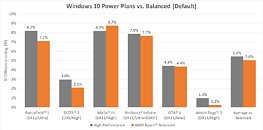Raevenlord
News Editor
- Joined
- Aug 12, 2016
- Messages
- 3,755 (1.23/day)
- Location
- Portugal
| System Name | The Ryzening |
|---|---|
| Processor | AMD Ryzen 9 5900X |
| Motherboard | MSI X570 MAG TOMAHAWK |
| Cooling | Lian Li Galahad 360mm AIO |
| Memory | 32 GB G.Skill Trident Z F4-3733 (4x 8 GB) |
| Video Card(s) | Gigabyte RTX 3070 Ti |
| Storage | Boot: Transcend MTE220S 2TB, Kintson A2000 1TB, Seagate Firewolf Pro 14 TB |
| Display(s) | Acer Nitro VG270UP (1440p 144 Hz IPS) |
| Case | Lian Li O11DX Dynamic White |
| Audio Device(s) | iFi Audio Zen DAC |
| Power Supply | Seasonic Focus+ 750 W |
| Mouse | Cooler Master Masterkeys Lite L |
| Keyboard | Cooler Master Masterkeys Lite L |
| Software | Windows 10 x64 |
In another Community Update from Robert Hallock, some more developments on the platform have been announced, after the last one's commitment to upcoming updates. AMD has done good on their promise for an optimized power profile for Windows systems that better leverages Ryzen's design and features.AMD's SenseMI technology allows the processor to fine-tune voltages and frequency on-the-fly, with a much higher granularity and lower latency than any software-based solution - such as Windows 10's power plans. These transitions between frequencies and voltages are governed by "P-States", which are frequency/voltage combinations requested by the operating system.
It so happens that Windows 10's Balanced power plan delays changes towards faster P-states - which bring increased frequency and voltage and hence, power consumption - so as to save more power. However, this means that there is an increased delay (latency) between the moment more processing power is required of the Ryzen processor and the moment the processor is allowed to change P-states to deliver it. Add to this the fact that Ryzen takes a significant performance hit with core-parking enabled, and Windows 10's balanced power plan attempts to park all logical processors beyond the first 10% whenever possible means that most of Ryzen's cores will have to be unparked before they can process any kind of workload - and this in itself incurs in an increased latency and, therefore, performance penalty.


AMD's "Ryzen Balanced" power plan works by reducing the timers and thresholds for P-state transitions to improve clockspeed ramping, which lets the processor's SenseMI technology do its work; and disables core parking altogether (which really shouldn't be a problem, considering Ryzen's energy-efficient design.) AMD says that the performance gains are actually on par with the High Performance plan in various games, on a computer configured with an AMD Ryzen 7 1800X, a Gigabyte GA-AX370-Gaming5, 2x 8 GB DDR4-2933, a GeForce GTX 1080 (378.92 driver), and Windows 10 x64 (build 1607).

AMD says there are other games they've seen benefits in (Total War: WARHAMMER, Alien: Isolation, Crysis 3, Gears of War 4, Battlefield 4, Project Cars and other unnamed ones). AMD says that not every game behaves in a way where a change in power plans has an impact on the Ryzen processor, but there is definitely a considerable number of them to warrant a change.
It really is commendable to see AMD so invested with its community updates, improving a platform that had some quirks on launch day (and still has, though fewer in number.)
View at TechPowerUp Main Site
It so happens that Windows 10's Balanced power plan delays changes towards faster P-states - which bring increased frequency and voltage and hence, power consumption - so as to save more power. However, this means that there is an increased delay (latency) between the moment more processing power is required of the Ryzen processor and the moment the processor is allowed to change P-states to deliver it. Add to this the fact that Ryzen takes a significant performance hit with core-parking enabled, and Windows 10's balanced power plan attempts to park all logical processors beyond the first 10% whenever possible means that most of Ryzen's cores will have to be unparked before they can process any kind of workload - and this in itself incurs in an increased latency and, therefore, performance penalty.


AMD's "Ryzen Balanced" power plan works by reducing the timers and thresholds for P-state transitions to improve clockspeed ramping, which lets the processor's SenseMI technology do its work; and disables core parking altogether (which really shouldn't be a problem, considering Ryzen's energy-efficient design.) AMD says that the performance gains are actually on par with the High Performance plan in various games, on a computer configured with an AMD Ryzen 7 1800X, a Gigabyte GA-AX370-Gaming5, 2x 8 GB DDR4-2933, a GeForce GTX 1080 (378.92 driver), and Windows 10 x64 (build 1607).

AMD says there are other games they've seen benefits in (Total War: WARHAMMER, Alien: Isolation, Crysis 3, Gears of War 4, Battlefield 4, Project Cars and other unnamed ones). AMD says that not every game behaves in a way where a change in power plans has an impact on the Ryzen processor, but there is definitely a considerable number of them to warrant a change.
It really is commendable to see AMD so invested with its community updates, improving a platform that had some quirks on launch day (and still has, though fewer in number.)
View at TechPowerUp Main Site





 Good on AMD to optimize it for everyone this easily
Good on AMD to optimize it for everyone this easily


